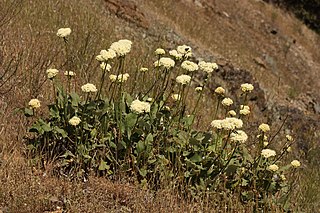
Eriogonum is a genus of flowering plants in the family Polygonaceae. The genus is found in North America and is known as wild buckwheat. This is a highly species-rich genus, and indications are that active speciation is continuing. It includes some common wildflowers such as the California buckwheat.

Eriogonum fasciculatum is a species of wild buckwheat known by the common names California buckwheat and flat-topped buckwheat. Characterized by small, white and pink flower clusters that give off a cottony effect, this species grows variably from a patchy mat to a wide shrub, with the flowers turning a rusty color after blooming. This plant is of great benefit across its various habitats, providing an important food resource for a diversity of insect and mammal species. It also provides numerous ecosystem services for humans, including erosion control, post-fire mitigation, increases in crop yields when planted in hedgerows, and high habitat restoration value.

Eriogonum arborescens is a species of wild buckwheat known by the common name Santa Cruz Island buckwheat.
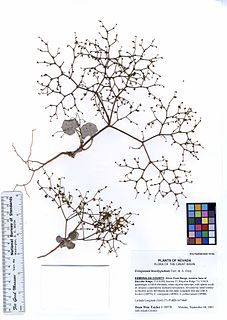
Eriogonum brachypodum is a species of wild buckwheat known by the common name Parry's buckwheat. This annual herb is native to the southwestern United States from California to Utah and especially the Mojave Desert. It grows in sandy and gravelly substrates. It has a skeletonlike spindly stem which branches many times. It can grow 5 to 50 centimeters in height and up to a meter in width. There is an array of rounded, dark-colored leaves around the base. Leaves are a few centimeters long and fuzzy on the undersides. Most of the plant is actually the spreading inflorescence. At intervals on the otherwise naked branches hang tiny clusters of glandular flowers a few millimeters wide in involucres of bell-shaped bracts. Each flower is less than three millimeters wide.

Eriogonum cinereum is a species of wild buckwheat known by the common names coastal buckwheat and ashyleaf buckwheat.
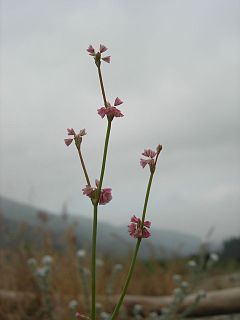
Eriogonum davidsonii is a species of wild buckwheat known by the common name Davidson's buckwheat. This plant is native to the southwestern United States and northern Baja California. It grows in sandy or gravelly soils, mixed grassland, saltbush, chaparral, sagebrush communities as well as oak and montane conifer woodland. It is a spindly annual herb growing up to 40 centimeters in height. Leaves are fuzzy, basal, and round with wavy or wrinkly margins fuzzy. They are two centimeters wide. The plant is variable in appearance, but is usually erect with thin, naked, neatly branching stems bearing clusters of tiny flowers at widely spaced nodes. Each flower is about 2 millimeters wide, bell-shaped, and can be white, pink or red. Flowering occurs May to September.
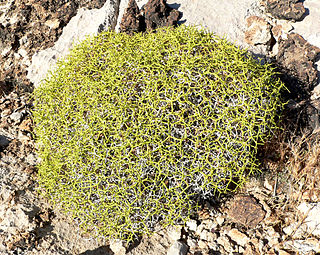
Eriogonum heermannii is a species of wild buckwheat known by the common name Heermann's buckwheat. It is native to the southwestern United States from California to Utah where it grows on rocky slopes, desert flats, and dry washes.
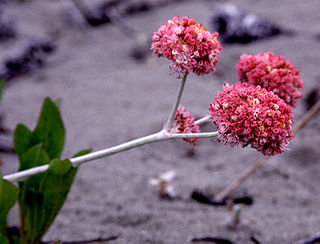
Eriogonum latifolium is a species of wild buckwheat known by the common names seaside buckwheat and coast buckwheat. This plant is native to the coastline of the western United States from Washington to central California, where it is a common resident of coastal bluffs and scrub.

Eriogonum lobbii is a species of wild buckwheat known by the common name Lobb's buckwheat or prostrate buckwheat. It is native to most of the mountain ranges of northern California and their extensions into Oregon and Nevada. It is found in a number of mountain plant communities.
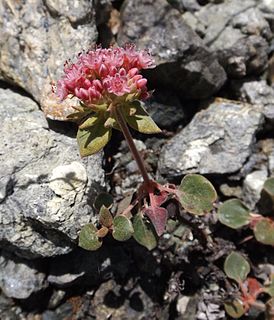
Eriogonum nervulosum is a species of wild buckwheat known by the common name Snow Mountain buckwheat. This uncommon plant is endemic to the inland North Coast Ranges of California, where it is known from only a handful of occurrences, most of which are in Lake County. It is named for Snow Mountain, a local peak.
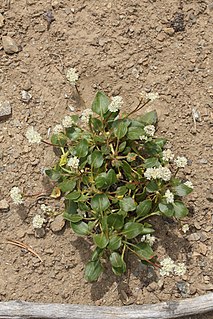
Eriogonum pyrolifolium is a species of wild buckwheat. It is native to western North America, from British Columbia to the high mountains of California.

Eriogonum strictum is a species of wild buckwheat known by the common name Blue Mountain buckwheat. It is a common plant of western North America from northern California to British Columbia where it is found along rocky slopes and scrubland. It flowers early in the summer.

Eriogonum wrightii is a species of wild buckwheat known by the common names bastardsage and Wright's buckwheat. It is native to the Southwestern United States, California, and northwest Mexico, where it grows in many plant communities, such as chaparral, in rocky habitats from mountains to deserts.
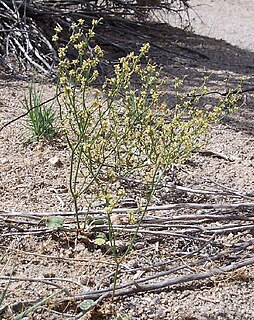
Eriogonum ampullaceum is a species of wild buckwheat known by the common name Mono buckwheat.
Eriogonum apiculatum is a species of wild buckwheat known by the common name San Jacinto buckwheat. It is endemic to California, where it is known from the San Jacinto, Santa Rosa, Palomar, and Cuyamaca Mountains of San Diego and western Riverside Counties. Its habitat includes chaparral and wooded slopes on granite sands. This is an annual herb producing a spreading to erect, glandular stem up to 90 centimeters tall. The oblong leaves appear at the base of the plant. They are hairy and glandular in texture. Most of the stem is made up of the inflorescence, branching, spindly cyme with clusters of flowers at the tips of the branches. The individual flowers are under 3 millimeters wide and are white in color with reddish stripes.

Eriogonum brachyanthum is a species of wild buckwheat that is commonly known as shortflower buckwheat. It is native to eastern California and western Nevada, particularly the Mojave Desert region, where it is common to abundant, and even sometimes weedy. It is also known from southern Oregon. The plant grows in sandy habitats such as desert flats and sagebrush. It also grows in pinyon-juniper and montane conifer woodlands. It is an annual herb that grows 30 to 40 centimeters tall. Leaves are located at the base of the stem, woolly, and oval or rounded in shape. The top of the stem is occupied by a branching inflorescence bearing many widely spaced clusters of flowers. Each individual flower is about a millimeter wide and light yellow in color. Flowers bloom from April to November.

Eriogonum butterworthianum is a rare species of wild buckwheat known by the common name Butterworth's buckwheat. It is endemic to the Santa Lucia Mountains of central Monterey County, California, where it is known from a few occurrences in the wilderness southeast of Big Sur in the vicinity of Junipero Serra Peak. Its native habitats include oak and conifer woodlands, chaparral communities, and sandstone outcrops. Eriogonum butterworthianum is a small clumpy shrub or subshrub that grows up to about 30 centimeters tall and wide. Leaves are 2 centimeters long and reddish-green in color. They are woolly, oval in shape, and curled under at the edges. The inflorescence is a cluster of flowers up to 2 or 3 centimeters wide. Each individual flower is a few millimeters wide and dull yellowish to pinkish in color. Flowers bloom June to September.

Eriogonum contiguum is an uncommon species of wild buckwheat. It is commonly known as Reveal's buckwheat and annual desert trumpet. It is native to Death Valley in California and adjacent sections of Nevada. It is commonly found in Death Valley National Park and Mojave National Preserve. Eriogonum contiguum grows in sandy to gravelly flats and slopes, or rocky hills, and lower bajadas with Atriplex species. It is an annual herb which produces an erect, spreading stem up to about 30 centimeters high. Leaves are basal, small rounded, and woolly. The many scattered inflorescences are small, compact clusters of tiny hairy yellow flowers. Flowers bloom April to June. It is threatened due to habitat degradation by off road vehicles, competition with exotic plant species, trampling, grazing, and erosion.

Eriogonum gracile is a species of wild buckwheat known by the common name slender woolly buckwheat.

Eriogonum callistum is a rare species of wild buckwheat, known by the common name Tehachapi buckwheat.


















